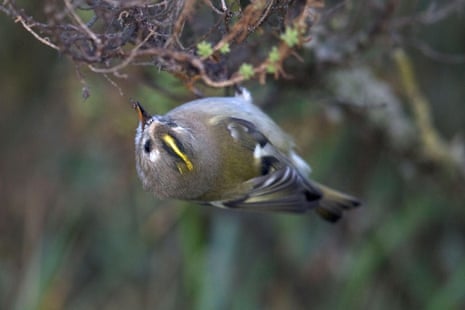Top Stories
Vibrant Goldcrest Shines Amid Gloomy Moorland Landscape

On a recent moorland excursion, the atmosphere shifted dramatically as the day unfolded. Initially, thick clouds obscured the sun, dimming the landscape and draining color from the surrounding woods. This grey backdrop suggested a mundane day ahead, yet as the afternoon progressed, the clouds began to dissipate, allowing vibrant hues to re-emerge like someone turning up a dimmer switch.
Nature’s Surprises
As the light returned, the yellowing birch leaves came alive, providing a stunning contrast to the muted scenery. While navigating the steep terrain, an unexpected discovery awaited: the Russula cyanoxantha, commonly known as the charcoal burner mushroom. Its cream-tinged underside radiated a bright glow, enhancing the unusual ambiance of the pre-dusk environment.
The sound of movement among the birches captured my attention, revealing a goldcrest, the smallest bird species in Britain. Known for its delicate, liquid song, this little creature became the highlight of the day. The strange light illuminated the narrow yellow stripe on the goldcrest’s head, indicating a female, as males typically display a more vibrant orange hue.
Color and Survival
The striking coloration of the goldcrest, even in a subdued setting, showcased the bird’s resilience. This vivid streak of yellow not only drew the eye but also represented a biological advantage. Goldcrests, like several other birds including flamingos, derive their color from carotenoids found in their diet, which consists mainly of tiny invertebrates and insect eggs. These carotenoids serve as antioxidants that enhance the bird’s immune function.
However, there is a balance between health and reproductive success tied to color intensity. Male goldcrests invest more energy in converting carotenoids into brighter orange crests, which play a crucial role in attracting potential mates. A more vibrant crest signals superior health and foraging skills, qualities essential for nurturing the numerous offspring they will produce in the spring.
Goldcrests are known for their prolific breeding, often laying between ten to twelve eggs in two broods, with the second brood starting before the first has fledged. The chicks emerge weighing only half a gram, blind and hairless, but rapidly grow to an adult weight of around six grams within two weeks. The resilience of the goldcrest, particularly evidenced by the vibrant crown of this female, suggests it is well-prepared to endure the challenges of winter.
This vivid encounter on the moor serves as a reminder of the wonders of nature, even on the dreariest of days. Under the Changing Skies: The Best of the Guardian’s Country Diary, 2018-2024, published by Guardian Faber, captures such moments vividly, highlighting the beauty and intricacies of the natural world.
-

 Health2 months ago
Health2 months agoNeurologist Warns Excessive Use of Supplements Can Harm Brain
-

 Health3 months ago
Health3 months agoFiona Phillips’ Husband Shares Heartfelt Update on Her Alzheimer’s Journey
-

 Science3 weeks ago
Science3 weeks agoBrian Cox Addresses Claims of Alien Probe in 3I/ATLAS Discovery
-

 Science3 weeks ago
Science3 weeks agoNASA Investigates Unusual Comet 3I/ATLAS; New Findings Emerge
-

 Science3 weeks ago
Science3 weeks agoScientists Examine 3I/ATLAS: Alien Artifact or Cosmic Oddity?
-

 Science2 weeks ago
Science2 weeks agoNASA Investigates Speedy Object 3I/ATLAS, Sparking Speculation
-

 Entertainment4 months ago
Entertainment4 months agoKerry Katona Discusses Future Baby Plans and Brian McFadden’s Wedding
-

 World2 months ago
World2 months agoCole Palmer’s Cryptic Message to Kobbie Mainoo Following Loan Talks
-

 Entertainment3 months ago
Entertainment3 months agoEmmerdale Faces Tension as Dylan and April’s Lives Hang in the Balance
-

 Science2 weeks ago
Science2 weeks agoNASA Scientists Explore Origins of 3I/ATLAS, a Fast-Moving Visitor
-

 Entertainment4 months ago
Entertainment4 months agoLove Island Star Toni Laite’s Mother Expresses Disappointment Over Coupling Decision
-

 Entertainment3 months ago
Entertainment3 months agoMajor Cast Changes at Coronation Street: Exits and Returns in 2025









